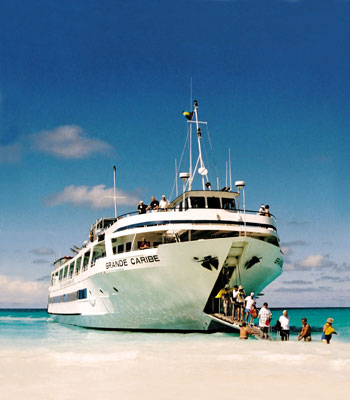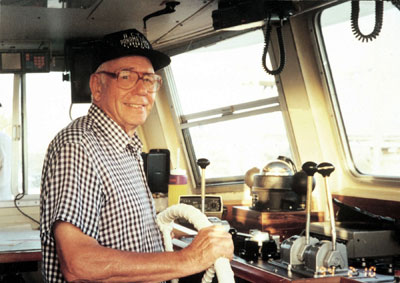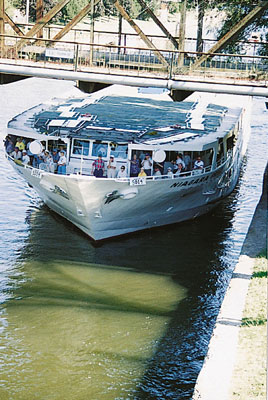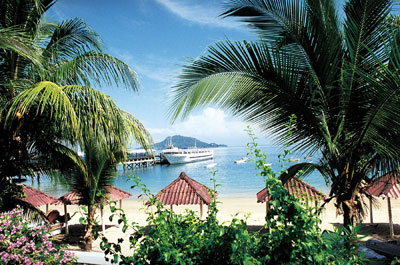Long name, low cost, high ratings — ACCL
This item appears on page 73 of the March 2009 issue.
by Lew Toulmin
The American Canadian Caribbean Line has its long name on the sides of some of the shortest ships in the cruising fleet. But ACCL is not short on hospitality, good food, great staff, interesting history or fascinating destinations.
In this article I will describe the line and its ships and outline the line’s international destinations, though my experience with ACCL is based on a cruise I took up the Intracoastal Waterway on the US Eastern Seaboard aboard the Grande Caribe in May ’08. My wife, Susan, and I were guests of ACCL.
Characteristic of ACCL
ACCL got its start in 1966 when the legendary Luther Blount (1916-2006), a shipbuilder from Rhode Island who had built over 300 vessels, decided to get into cruising. He built small ships, each carrying fewer than 100 passengers, and started cruising the canals, rivers and coastal waterways of the US.
Eventually, he expanded to international cruising in Central and South America, the Panama Canal and the Caribbean. His philosophy was that cruising should be like cruising on your friend’s yacht.
Luther even patented a major cruising invention: the integrated bow ramp. This narrow passenger ramp is built into the bow of the ship and can be lowered, allowing the vessel to be driven up onto remote beaches to disembark passengers. Almost all other expedition vessels have to carry numerous Zodiacs (inflatable boats that each carry about 10 passengers) to ferry people to the beach. ACCL ships do not need Zodiacs.
Another useful feature of ACCL vessels is the retractable pilothouse. The entire pilothouse, about 12 feet square, can drop down 10 feet so the ship can pass under bridges that are only 19 feet above the water.
Luther also listened to his passengers — a rarity! — and made changes accordingly. According to Dixie Keith, First Mate of the Grande Caribe, “Luther and, now, his descendants who run the business read every single passenger comment sheet. Passengers have a lot of clout in this company.”
Currently, the line has three similar ships: Grande Caribe, Grande Mariner and Niagara Prince. All ACCL ships are inspected by the US Coast Guard and meet stringent safety standards.
Grande Caribe
The vessel Susan and I took, Grande Caribe, built in 1997, measures 183 feet in length, with a 40-foot beam and a draft of only 6'6". This short draft allows the vessel to enter remote waters that large cruise ships can only dream about. With 50 cabins, she has a maximum capacity of 100 passengers but often sails, as we did, with only 35 or so.
The ship has a rather flat bottom, designed for navigating coastal waterways. There are no stabilizers, hence the vessel rolls at sea somewhat when there are waves perpendicular to the ship’s line of travel. The most desirable cabins are forward and up on the second deck, away from the engine room.
The cabins are small and the décor is simple, with no plush surfaces or fixtures. On the Grande Caribe, the cabins and public areas, which had not been redone in some years, were refurbished in the summer of 2008. Note that, even after the refurbishment, the feel of the ship is still fairly plain, with simple fabrics and rugs stretched over metal walls and decks.
Toilets in the cabins are small. There are no bathtubs. Each shower is in the toilet area, which converts to the shower stall by means of a circular curtain that pulls around you. There is plenty of hot water. Bring your own shampoo; the only toiletries provided are soap, Kleenex and toilet paper.
All ACCL ships use the US standard 120V AC outlets.
Casual dining
On our Grande Caribe cruise, the crew members were young, enthusiastic and very eager to please. Many were from Rhode Island and had long family ties with the company.
Our cruise director, Mark Alvarez, was one of the best cruise directors Susan and I have ever had — smiling, genuine, efficient and caring and a very hard worker.
The dress code on board is always casual. Coats and ties are unnecessary. At the first and last Captain’s dinners, we noticed that most men wore nice polo or dress shirts and nice slacks, while most women wore similar outfits or perhaps summer dresses.
Meals are open seating at round tables accommodating about 10 passengers. Breakfast is buffet style, but lunch and dinner are sit-down, served meals.
We found the quality of the food to be high and the quantity plentiful. The chefs, usually recruited from the well-regarded Johnson & Wales University or the Culinary Institute of America, are not aiming for haute cuisine but for very tasty, home-style cooking. They succeed.
A typical dinner on board consisted of a Greek salad for a starter, followed by fillet of beef with Hollandaise sauce, rice pilaf, tomato-basil bread and a dessert of crème brûlée. It was excellent.
A wonderful feature of ACCL is a careful effort to avoid “nickel and diming” the passengers. Many cruise lines today are constantly trying to sell the passengers jewelry, clothing, high-priced excursions, high-priced liquor, overpriced soft drinks and other items to add to their profits. ACCL is just the opposite.
In fact, ACCL is one of the only cruise lines in the world that has a BYOB (Bring Your Own Booze) policy! If you want to drink, just buy some cheap liquor at your local Costco and bring it aboard! There is no corkage fee.
Generally, there are one or two free rounds of mixed drinks or wine, with hors d’oeuvres, offered in the lounge before dinner. Soft drinks, coffee, tea and snacks are free at the soda fountain in the lounge, 24/7.
The ship’s layout
On the Grande Caribe, the main public spaces other than the dining room are the lounge and the upper deck. Stair lifts are installed to help passengers who need assistance.
The lounge is forward, with large windows, and is the focus of the social scene. There are no Broadway-style shows, but there usually is a lecture or character reenactor each evening plus passenger games or movies.
When GPS maps of the area are available, these are continually projected onto a wide screen in the lounge. This is a great feature, as it shows exactly where the ship is and what landmarks you are looking at as you cruise along in a relaxed style. Bring your sunglasses and binoculars!
The upper deck, partially protected with an awning, has a great view of the sea and is a terrific place for relaxing on nice days. There is no gym or pool, but 17 times around the deck makes a mile of walking.
Since the ship is so small, it is easy to get to know your fellow passengers and exchange travel tales.
There is no expensive ship’s store, just a 2-hour period at the end of the voyage where you can buy an ACCL T-shirt, cap or fleece. Credit cards generally are not accepted on board, so bring enough cash (or a personal check) for tips at the end of the voyage and to pay for excursions.
Cruises and shore trips
Shore excursions are extremely reasonably priced on the Grande Caribe. We usually paid $15 to $40 per person for city tours of one to three hours, and in remote areas there often was no charge for guided shore excursions. According to First Mate Dixie, a typical excursion off a remote part of Belize might include a trip in a cayuga (dugout canoe) or in the ship’s glass-bottomed boat.
ACCL’s international destinations for 2009 include Belize, Guatemala and Honduras, with a focus on barrier reefs and visiting exotic small islands and remote villages. Voyages are 11 days long, and all depart from Belize City. Prices, which do not include airfare, range from $3,045 to $3,685 per person plus $250 in port charges.
Other destinations for 2009 include the Intracoastal Waterway, the Great Lakes, the Erie Canal, the Mississippi and Hudson rivers and the St. Lawrence Seaway.
An early-arrival policy is usually in place for ACCL voyages, with a charge in the range of $95 per cabin. This means that you can plan to arrive at the departure port and board the ship the day before the actual departure of the vessel — eating dinner, sleeping in your own cabin and then having breakfast aboard the next morning — allowing you flexibility in case your plane connections are problematic.
I always recommend arriving a day or more ahead of the departure date for any cruise. This gives time to explore the departure port and eliminates worrying about a missed connection.
ACCL vessels average about 65%-70% repeat business — quite high within the cruise industry. After 10 trips on ACCL, you get one trip free.
For more information, see a travel agent or contact American Canadian Caribbean Line (Box 368, Warren, RI, 02885; 800/556-7450 or 401/247-0955, www.accl-smallships.com).
Lew Toulmin is the author of “The Most Traveled Man on Earth,” available for $16.95 plus $5 shipping from The Village Press (13108 Hutchinson Way, Silver Spring, MD 20906; www.themosttraveled.com). You can reach him by e-mail at lewtoulmin@aol.com.




